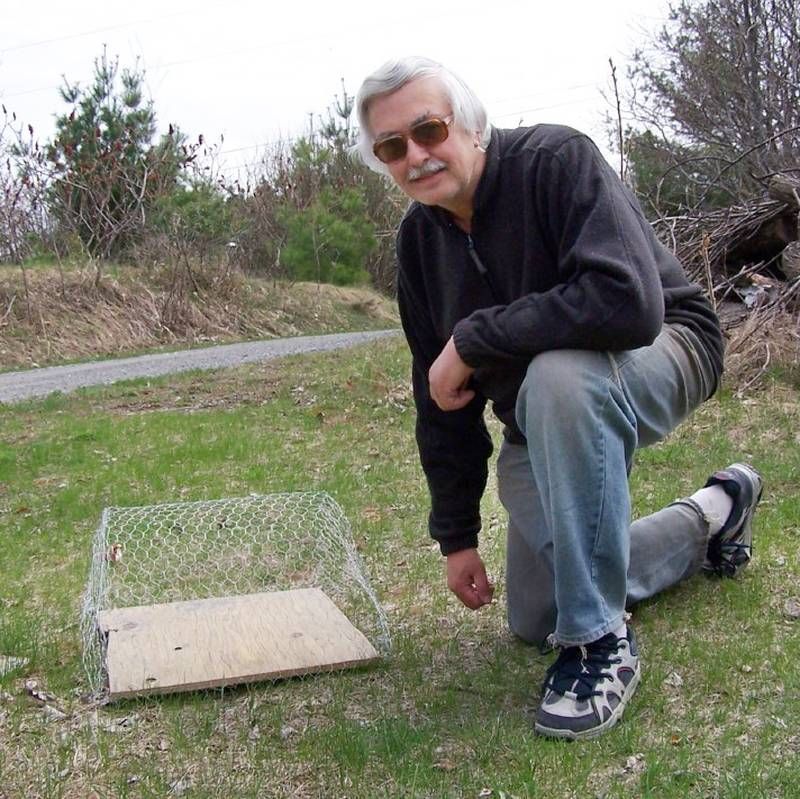Juana Gramajo | Jul 26, 2023
Since retiring and making Bob’s Lake his permanent home, Pat Grace has focused his attention to turtle conservation. Every summer, Pat waits for turtles to come ashore and lay their eggs. Knowing that nests are most vulnerable in the first few days, he gets to work immediately. While Pat usually tends to several nests on his property, he says there have been fewer in more recent years, and only one for this year. Pat maintains hope and works diligently to ensure this nest is a success.
He has gone through several trials to figure out the most effective way to protect turtle nests.
“I found that full-sized pallets were the only thing that the raccoons could not move. But pallets have to be removed in the daylight hours to allow sunlight to hit the nests. Also, pallets often have wide enough openings between the slats that raccoons may be able to dig through the middle of the pallets.”
Since then, he tried chicken-wire cages, which were effective for a short time, but the raccoons soon figured those out, too. His current nest protectors are heavy-duty metal cloth, secured into the ground with 8 tent stakes. “These allow the sun in, can be mowed over, and can be easily made by anyone.” He adds that materials can be easily sourced at local hardware stores.
Pat has worked with the Toronto Zoo and the local township to install turtle crossing signs in the area and he often stops to help them cross the road. Protecting turtles has become Pat’s passion project, and with nests on the decline, it’s an important job. Pat is optimistic that the turtles he helped hatch successfully in years prior will return once they are mature, to lay their eggs on his property. Turtles are known to return to the area they were born to nest.
Northern Map turtles, which are common around Bob’s Lake, can take 10 years or longer to mature. Through careful observation, Pat has been able to identify some of the turtles that swim around him. He states that Northern Map turtles have distinguishable markings on their necks, to differentiate from one another. With the use of his long-range camera, he is able to capture beautifully detailed photos of their neck markings, which he is planning to use for reference when they reach maturity.
Pat continues to provide information on turtle conservation locally. He frequently attends our Community Café program at Rural Frontenac Community Services, and has presented photos and information to our group in Piccadilly. As we are planning our fall schedule, Pat has offered to give a presentation at our program, to continue to raise awareness on turtle conservation. Though he is retired, his work with turtles keeps him busy through the summer and fall. His face lights up with the mention of turtles and will happily share information, fun facts, and photos. Pat’s work to protect turtles will have a lasting impact, allowing for future generations of turtles to thrive. Thanks to Pat’s dedication to turtles, our Frontenac wetlands will remain healthy and bountiful, for us all to enjoy.
More Stories
- Latest CUPW Job Action Stops Postal Delivery Of The Frontenac News Forcing Alternate Plans
- Opponents of Barbers Lake Gravel Pit Pack Ag Hall in McDonalds Corners
- Bobsleigh Olympian Jay Dearborn At Mikes Pizza In Sydenham
- The Loins Club Of and O'Lakes Roar
- North Frontenac Back Roads Studio Tour - September 27 and 28
- Sunday Market Vendors Give Back
- George Street Work As Town Hall Renovation Nears Completion
- One Way Street Plan Hits A Dead End - Central Frontenac Council, September 9
- Global Gardening
- No Winner Yet in Catch The Ace But Fundraising Target Met

